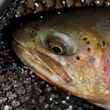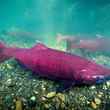Raritan Bay is home base for many of New York and New Jersey’s fishermen. In season fishermen leave the many marinas that dot the bay shore of Staten Island, Monmouth and Middlesex county and head out to the bay in search of striped bass, bluefish, summer flounder (fluke) and other game fish. In order to have a successful day on the bay, anglers look for baitfish. Find the bait, you find the gamefish. The predominant baitfish in Raritan Bay is bunker (formally known as Atlantic Menhaden), both large adults and immature small bunker that we call “peanuts”. Without bunker in the water, you might as well play golf.
Ranked right up there with the Chesapeake and Delaware bays, Central New Jersey’s Raritan Bay is one of the predominant nurseries/estuaries for Atlantic Menhaden stocks. Bunker spawn out at sea and the fry get caught up in the currents and ride them into the back bays and estuary areas where they stay the summer and grow larger until fall. The adult bunker are herring-like fish which swim together in very large schools and feed on micro-organisms like algae, copepods and plankton. They are a lynchpin in the ecology of the bay – converting the micro organisms into flesh and becoming a protein enriched package for our carnivorous fish, marine mammals and marine birds.
As the waters warm in the spring, adult bunker swarm into the western end of Raritan bay, near the mouth of the Raritan river, the Arthur Kill and surrounding waters. Predators like striped bass load up on them before making the trek up river to spawn. Yes, the Raritan river has a recovering and viable population of striped bass born and raised in the river! Since the mid 80’s, the water quality has dramatically improved and the bass have returned and get bigger and bigger each year. The bunker connection between the stripers and other gamefish is obvious, and really makes you wonder what would happen if the bunker disappeared? We have already witnessed the complete disappearance of the weakfish in Raritan Bay and it is said that this is due to the loss of bunker in the Chesapeake, a major spawning ground for them. If this happened in those waters, imagine how badly the Raritan River and Bay would change if these vital fish were removed from the ecosystem?
Adult bunker are one of the most sought after commercial species along the Atlantic coast. In recent years their population has crashed down to dangerous levels. There has been a decline of 86% over the last 30 years. Current bunker populations are now at dangerous levels. The term 'overfishing' has been thrown around a lot lately, but it’s the only accurate term used by Marine biologists to describe when fish are taken out of the ecosystem faster than nature can replace them. This past spring, an ASMFC study team determined that that overfishing has occurred 32 out of the past 54 years. It may be hard to believe that this is allowed to occur, but the story surrounding Menhaden is filled with political twists and turns. Since the late 1800’s, this vital species has been removed from the waters without restrictions of any kind.

At present, there is no limit or “cap” on the amount of bunker that can be landed from the ocean or the bays. Sustained industrial overfishing has landed us where we are today, and as usual, the recreational fisherman take the hit. Anybody that spends time on the bay can see the changes before our eyes. The bunker are just not there, and when they do show, there are far less than before. We are the ones that wind up with less fish to catch and slow fishing turns into no fishing, which is bad for everyone involved. Spring fishery aside, each fall there was typically acres and acres of “peanuts” migrating out to sea, creating a bonanza for striper, bluefish and weakfish anglers. For the past two seasons, this angler has searched high and low for those little guys only to find a few pods here and there. So far this year, I have been happy to hear scattered reports of peanut bunker in backwater marina areas, but only time will tell if we will have enough to make for decent migration and ultimate, a great fall fishing season. Clearly, it is not what it used to be and something is very wrong.
The commercial menhaden fishery is made up of two sectors, a reduction fishery that comprises approximately 80 percent of landings, and a bait fishery that harvests the remaining 20 percent The modern reduction fishery grinds menhaden into fish meal and oil for use in aquaculture feed, pet foods, livestock feed and dietary supplements. A single company is responsible for the menhaden reduction industry on the Atlantic Coast. A company named Omega Protein, Inc. Omega Protein continues to remove menhaden each day at a rate that makes it nearly impossible for the fish population to sustain itself.
At its shareholder meetings, Omega Protein spokesmen proclaim and reassure shareholders that there are more bunker than ever before and that they are a “friend to the sea” and they have always and will always fish in a sustainable manner, adding how increased demand from foreign fish farms is providing solid growth and room for expansion. The future illustrated is a very bright one for Omega Protein, as the bunker resource is portrayed as endless. Nothing could be further from the truth.

Just a few miles South East of Raritan Bay, out in the EEZ (starting 3 miles off our shoreline), Omega is busy indiscriminately strip mining the waters of the NY/NJ Bight. Omega Protein sets nets from Sandy Hook, NJ all the way back and past Reedville, Virginia where Omega’s main East Coast processing plant is located. They are catching the same big bunker that are providing the Raritan Bay with young. Omega Protein intentionally targets older, larger fish because their oil and meal yield is far greater. However, as menhaden age, their fecundity -- or capacity to reproduce -- increases dramatically. The bait fish that are crucial to the future survival of Raritan Bay are disproportionately ending up in commercial nets.
As if this wasn’t enough, our local bunker are being assaulted from yet another angle. The remaining 20 percent (and growing) of the total Atlantic menhaden catch is attributed to the bait sector which provides menhaden for the huge lobster fishery that spans New England. Over the course of the last decade, the bait of choice, locally caught herring (Atlantic, Blueback and Alewife) has been wiped out. This is forcing lobstermen to seek another source of bait and bunker, or Pogy as they call them, are the only forage fish left good for this purpose. Yes, right here in the waters off of Long Island and Sandy Hook, New England-based, high capacity boats are traveling more than 350 miles to net bunker and bring them back home for the traps.
Traditionally, the Jersey based bunker fleets have been single boats that head out for the day, fill up and come home. They have been providing bait for use by recreational fisherman, lobster, crab and other uses. The single, under 50 feet, old fashioned bunker boat now appears like sustainable fishing when compared to the new way of doing things.
In order to keep up with the growing demand for more and more bait, netters in other ports have ramped up and are now using the same tactics as the offshore guys. They are also operating in “teams” and small vessels are now being accompanied by larger 90 foot high capacity, “carrier” type vessels, to optimize and increase daily catches to unprecedented levels.
The combination of Omega Protein's tonnage and the lobster bait boom is proving to be a lethal blow. Raritan bay anglers and beyond are witnessing localized depletion of menhaden and the gamefish that depend on them will surely follow. New England anglers have already seen all the pogy vanish before them and this is certainly a ghost of things to come our way if things don’t change quickly.
Raritan Bay’s recreational charter fishing fleets and related businesses cannot thrive without menhaden in the water. Clearly, the time to act is now, as for the first time in the history of this commercial fishery, the ASMFC (Atlantic States Marine Fisheries Commission) is taking public comment until November 2, 2011. Menhaden proponents need to speak up before they make their decision, and let them know that we care and that they desperately need to put a cap on this vital fishery and start a sincere effort to end overfishing and return menhaden stocks back to healthy levels.
Collectively we cannot allow big business to continue to strip mine our waters at the current pace, with complete and total disregard for all that depend on a healthy, balanced ecosystem. We must demand that the ASMFC do the right thing and put an end to the exploitation. It’s up to us, be it fisherman or concerned citizen to speak up, and demand that starting with the 2012 season, more adult menhaden are left in the water to reproduce and continue to support the marine food web.
To learn more about this issue, including how to make your voice heard, visit menhadendefenders.org.






























Comments